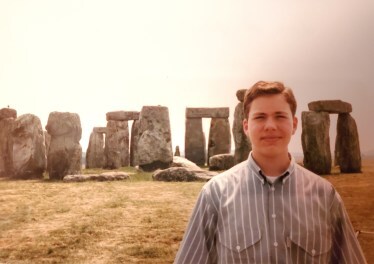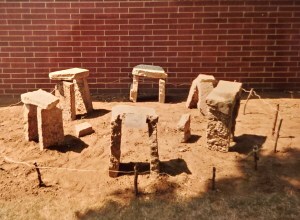Stonehenge: the day two outvoted three
“Well, can ya die ‘appy now thet ya’ve seen Stonehenge?” he asked.
It was an interesting question, but if you had a chance to visit England, what would be at the top of your list of places to see? Buckingham Palace? Big Ben? Those were on my list, but the top line belonged to England’s most famous pile of rocks, Stonehenge.
Guy and I, along with 14-year-old son Dan, had a chance to visit England the summer of 1989, when Guy’s sister and her husband (Lois and David) lived there, two hours north of London in Kings Lynn. They’d already seen Stonehenge and didn’t think it was worth the extra hour out of our way into London to visit.
I was relieved that the ancient relic was still at the top of Dan’s list (along with Hard Rock Cafe and a Dr. Who exhibit). Somehow the two of us outvoted the other three!
Getting there wasn’t easy. Traffic on the London Orbital was stop-and-go. The car’s open windows gave no relief from the heat and humidity. It was a miserable ride. Guilt nagged. But when we finally headed west, anticipation set in. Without warning, we crested a hill and there, spread out in the distance, was Salisbury Plain.
That first glimpse of the great grey boulders on the lonely expanse reminded me of toy blocks left behind by a gigantic creature that had tired of them. Dark specks dotting the vast isolated pasture turned out to be cows.
What causes the desire to spend time and effort to see ancient haphazard ruins? The enigmatic monument is certainly not a place of beauty, but is strangely alluring. Some of the ungainly stones stood on end, some shared lintels with others, some had fallen over, and many had been hauled away. Since 1978, people have not been allowed to walk among the huge, dull sandstone sarsens and blue-stones, but we circled nearly all the way around them. A solemnity seemed to silence the dozen or so tourists there.
 Dan at Stonehenge, June 1989. You can barely see a jackdaw perched on the stone at the left.
Dan at Stonehenge, June 1989. You can barely see a jackdaw perched on the stone at the left.A jackdaw flapped to the top of a massive upright where the silhouette of its mate waited.
I pondered the history and mystery of the place. How did primitive men haul 81 of these giants from 25 miles away, other large stones from as far away as 300 miles?
That was no easier to grasp than this imposing carcass of rocks was a Stone Age astronomical observatory, that the dull grey stones aligned with other stones and spaces so that primitive men could predict the seasons and even eclipses of the sun and moon.
Maybe it’s what we don’t know about this mute place is what makes it magical.
A helicopter circled overhead, insisting on our attention to the modern world. It was the week of the Summer Solstice and the Stones, as they call it, were closed for two days to thwart an invasion of hippies.
Before leaving, we cooled off with colas in the shade of a hawthorn shrub. A cabbie, who had brought more tourists to see the famous relic, asked loudly, “Well, can ya die ‘appy now thet ya’ve seen Stonehenge?” We all laughed.
“As a matter of fact, yes!” I admitted.
When Lois and David visited us at home, after they moved back to the States, our front bushes had been removed. Dan made a mini-Stonehenge there to welcome back his aunt and uncle.




